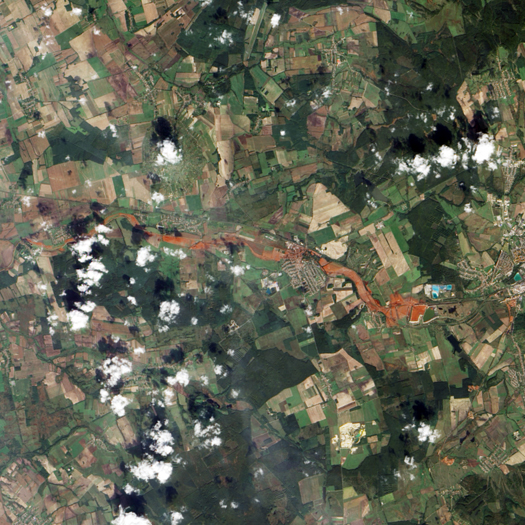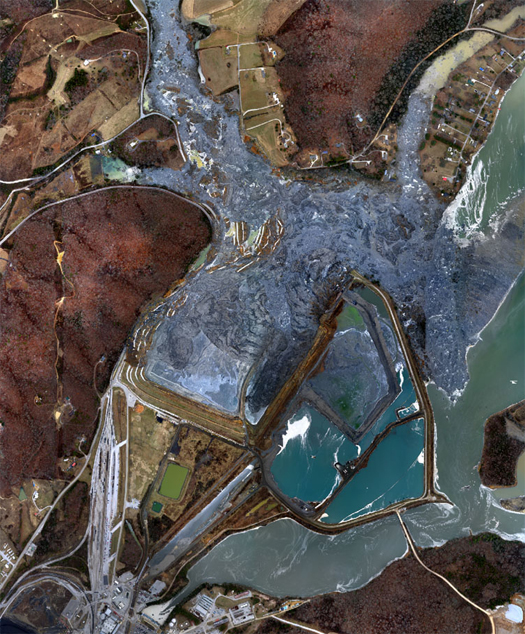
[A landscape in the process of becoming a different landscape:
In late 2010, the waste reservoir of a Hungarian aluminum oxide plant burst, releasing millions and millions of gallons of caustic red sludge. The meter-high toxic mudslide quickly moved downhill through two nearby villages, burying buildings, poisoning fields and killing 10 people.
The image above is from NASA Earth Observatory, while the descriptive quote is from a recent NPR story on the striking photographs of Spanish photographer Palindromo Meszaros, which capture the otherworldly post-mudslide landscape, and are well-worth a look.]
Brian Davis interviews Graham Harman on “landscape ontology” (Harman is speaking in the following quote):
There is a suburb of Iowa City called Coralville. While there is no coral reef anywhere near this suburb today, you will easily guess that there was coral here in the distant past: during the Devonian Era. During the 1993 Iowa floods (a precursor to the far more disastrous floods of 2008), water washed over the Coralville Dam and ripped all the soil from the nearby campsite, exposing a neo-Devonian fossil bed filled with creatures of almost Lovecraftian monstrosity.
What is the connection between Iowa in 1993 and the swarming neo-Devonian monsters of 360 million years ago? You can’t really say that “Iowa” forms the connection, and not just for the reason that Iowa as a political unit did not exist at that time. You can’t even say that the two things happened on the same physical landscape, since Iowa was apparently covered by sea at the time. Indeed, when I look at the position of the continents in late Devonian times I cannot easily determine where Iowa would have been on the map.
In a sense, then, the fossils themselves are the landscape. It is the fossils that link the Coralville of 1993 with the living creatures of the Devonian Era. I would say that a landscape is any object that links a wide variety of other objects that all use it as a mediator. A landscape is like a “wormhole” linking different times and different places or different classes of living organisms and inanimate objects. Through landscapes we are linked to the Native Americans who left a spearhead buried in what is now my parents’ front yard, as well as to the deer, moths, beetles, and viruses that inhabit the woods surrounding their yard, and with which I have only incidental contact.
The italics here are mine, because I find this definition of landscape quite fascinating — in part because of the great breadth of things that it permits us to understand as landscapes. If a fossil can be a landscape, what can’t? Landscape becomes a way of understanding objects rather than a specific class of objects, which is not unlike the argument I’ve made elsewhere that “infrastructural” (in which “infrastructure” becomes a specific kind of behavior that nearly any object can assume in relation to at least some other objects) is a more significant category than “infrastructure” (the collection of things immediately recognizable as infrastructures — roads, bridges, fiber-optic cables, wastewater treatment plants, and so on). As another example of the width of Harman’s definition: a building could easily be understood as a landscape, if, for instance, it serves as the linkage between a family of mice, a night watchman several decades ago who lost the key to the basement closet where those mice now nest, and the Gilded Age family whose wealth paid for the construction of the building.
I also rather like what this suggests about the landscape architect: that a key characteristic of landscape architecture as a pattern of thought is its propensity for understanding linkages between diverse and seemingly-unrelated phenomena at differing scales of time and space — how Devonian geologic movements affect contemporary vegetation patterns, how a measurement standardized in 1675 could determine the urban form of Dutch coastal cities in the twenty-first century, or how the arrangement of paths within a bounded site affects circulation within the surrounding city.

[A second landscape becoming yet another landscape: the coal ash slurry spill at the TVA Kingston plant in Tennessee, December 23, 2008 — one day after the spill. The spill released over five million cubic yards of slurry, covering the adjacent area in a coat of viscous sludge up to six feet thick. It was the largest such spill in American history. Image via wikipedia.]
I also enjoyed Harman’s thoughts on when a landscape becomes a different landscape:
“People have their graduations, weddings, and major awards; landscapes have their floods and explosions. When looking for the moments when a landscape became a substantially different thing, I would look for the moments when it entered into long-term symbiosis with some other thing— whether it be a human historic event, the intrusion of an invasive species, a cataclysmic physical change, or some other incident that marked the intertwining of the landscape with something else.”
It’s hard to read this and not be reminded of Manuel DeLanda’s co-option of terms from physics and mathematics like “phase transition”, “bifurcation”, and “far from equilibrium” in the introduction to a A Thousand Years of Nonlinear History:
If one allows an intense flow of energy in and out of a system (that is, if one pushes it far from equilibrium), the number and type of possible historical outcomes greatly increases. Instead of a unique and simple form of stability, we now have multiple coexisting forms of varying complexity (stable, periodic, and chaotic attractors). Moreover, when a system switches from one stable state to another (at a critical point called a bifurcation), minor fluctuations may play a crucial role in deciding the outcome. Thus, when we study a given physical system, we need to know the specific nature of the fluctuations that have been present at each of its bifurcations; in other words, we need to know its history to understand its current dynamical state.
…attractors and bifurcations are features of any system in which the dynamics are not only far from equilibrium but also nonlinear, that is, in which there are strong mutual interactions (or feedback) between components. Whether the system in question is composed of molecules or living creatures, it will exhibit endogenously generated stable states, as well as sharp transitions between states, as long as there is feedback and an intense flow of energy coursing throughout the system.
…much as a given chemical compound (water, for example) may exist in several distinct states (solid, liquid, or gas) and may switch from stable state to stable state at critical points in the intensity of temperature (called phase transitions), so a human society [or landscape!] may be seen as a “material” capable of undergoing these changes of state as it reaches critical mass in terms of density of settlement, amount of energy consumed, or even intensity of interaction.
There’s an interesting difference between the two metaphors being used to understand change in objects here: Harman uses a biological metaphor — symbiosis (a landscape becomes a different landscape when it adds a new symbiotic relationship) — and DeLanda uses a metaphor from physics — phase transition (where we might say a landscape becomes a new landscape when the aggregate input of changes reaches a certain threshold and tips the landscape into a radically different state). With the latter metaphor, change is detected by measuring the state of the landscape itself; with the former, change is detected by observing the kinds of relationships that the landscape has with other objects. (I shouldn’t push this too far, because DeLanda is also quite concerned elsewhere with relations — my point concerns the difference between these two metaphors, not a difference between DeLanda generally and Harman generally.)
My first reaction is that this suggests the importance of tracking relations to understanding (and thus to operating in and on) landscapes, which — given the centrality of mapping and drawing to understanding within both architecture and landscape architecture — in turn suggests that we’ll need to keep evolving more intricate and complex tools for mapping (and re-designing!) those relations. I suspect that doing so will require, at least in part, cross-breeding the kinds of maps and drawings we’re already comfortable making with examples from well-outside the fields, particularly examples that permit kinds of quantification and measurement that our current toolkit does not: topological maps re-inserted into measured space, material flow analyses, Odum diagrams, flow diagrams from industrial ecology, and so on.
[Read Davis’s full interview with Harman at FASLANYC. If you enjoy that interview, you might also enjoy this series of posts on Davis’s thesis blog: A Theory of Instruments, Radical Difference, and The Conceptual Triad.]

